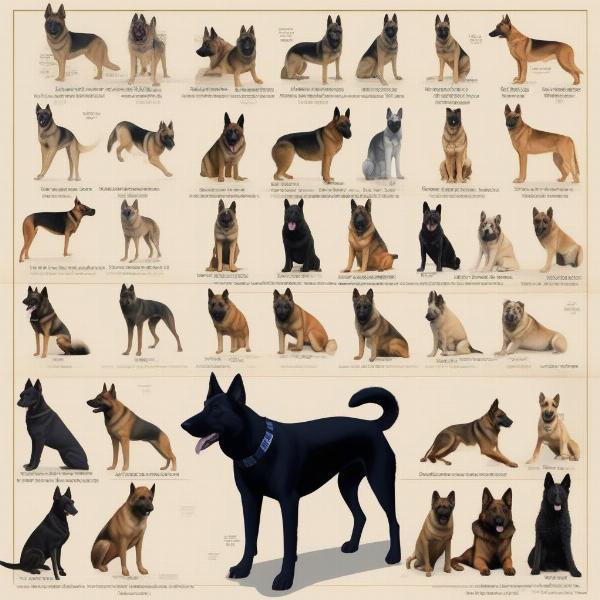K9 sheriff dogs play a crucial role in law enforcement, assisting with everything from drug detection to suspect apprehension. Understanding the specific guidelines surrounding their selection, training, and care is essential for ensuring both the dog’s well-being and their effectiveness in the field. These guidelines encompass a range of considerations, including breed selection, health protocols, training methodologies, and ongoing care requirements. This comprehensive guide will delve into the key aspects of K9 sheriff dog guidelines, providing valuable insights for both aspiring handlers and experienced professionals.
Selecting the right breed is the foundation of a successful K9 unit. Breeds commonly used in law enforcement, such as German Shepherds, Belgian Malinois, and Dutch Shepherds, are chosen for their intelligence, drive, and physical capabilities. However, individual temperament is equally important. A dog’s suitability for police work depends on its confidence, trainability, and ability to handle stressful situations. Rigorous testing and evaluation are conducted to identify candidates with the right combination of traits.
 K9 Sheriff Dog Breed Selection
K9 Sheriff Dog Breed Selection
Health and medical care are paramount for maintaining a K9 officer’s peak performance. Regular veterinary check-ups, vaccinations, and preventative measures against parasites are essential. Additionally, specialized care is required to address the physical demands of police work, including potential injuries sustained during training or deployment. Proper nutrition and a tailored diet are crucial for providing the energy and stamina needed for rigorous activities.
Training is the cornerstone of a K9 officer’s effectiveness. From basic obedience to specialized skills like drug detection or suspect apprehension, rigorous training is essential. Positive reinforcement methods are typically employed, focusing on building a strong bond between the handler and the dog. Ongoing training and regular practice are necessary to maintain proficiency and adapt to new challenges.
Essential K9 Training Techniques
Effective K9 training requires a combination of proven techniques and consistent application. Obedience training forms the foundation, establishing clear communication and control between the handler and the dog. Specialized training, tailored to the specific role of the K9 unit, follows. This might include scent detection for narcotics or explosives, tracking for missing persons, or apprehension techniques for apprehending suspects.
Building a Strong Handler-Dog Bond
The relationship between the handler and the dog is critical to the success of the K9 team. Building trust and rapport is essential, fostering a strong bond that enhances communication and teamwork. This bond is cultivated through consistent interaction, positive reinforcement, and shared experiences.
Ongoing Care and Retirement
Beyond training, ongoing care is crucial for maintaining a K9 officer’s well-being. Providing a balanced diet, regular exercise, and a stimulating environment are essential for both physical and mental health. As K9 officers age, they may require specialized care to address age-related health issues. Retirement plans should be considered to ensure a comfortable and secure life for these dedicated partners after their service.
Conclusion
K9 sheriff dog guidelines encompass a broad spectrum of considerations, from breed selection and health protocols to training methodologies and ongoing care. Adhering to these guidelines is essential for ensuring the well-being and effectiveness of these valuable law enforcement partners. By prioritizing the dog’s health, training, and overall welfare, we can maximize their potential and ensure their long-term success in serving and protecting our communities.
FAQ
- What are the most common breeds used as K9 sheriff dogs? German Shepherds, Belgian Malinois, and Dutch Shepherds are frequently chosen for their intelligence, drive, and suitability for police work.
- What type of training do K9 sheriff dogs undergo? Training includes basic obedience, specialized skills like scent detection or suspect apprehension, and ongoing practice to maintain proficiency.
- How is the health of K9 sheriff dogs maintained? Regular veterinary check-ups, vaccinations, preventative care, a balanced diet, and regular exercise are essential.
- What happens to K9 sheriff dogs after they retire? Retirement plans are implemented to provide a comfortable and secure life for these dogs after their service.
- How important is the bond between the handler and the K9 dog? The handler-dog bond is crucial for effective communication, teamwork, and the overall success of the K9 team.
ILM Dog is your trusted international resource for expert advice on dog care and breeding. We offer valuable insights into various aspects of dog ownership, from breed selection and health care to training and nutrition. Whether you’re a seasoned dog owner or just starting your journey, ILM Dog provides reliable information and resources to help you care for your canine companion. Contact us for more information at [email protected] or call +44 20-3965-8624. We’re here to support you every step of the way.